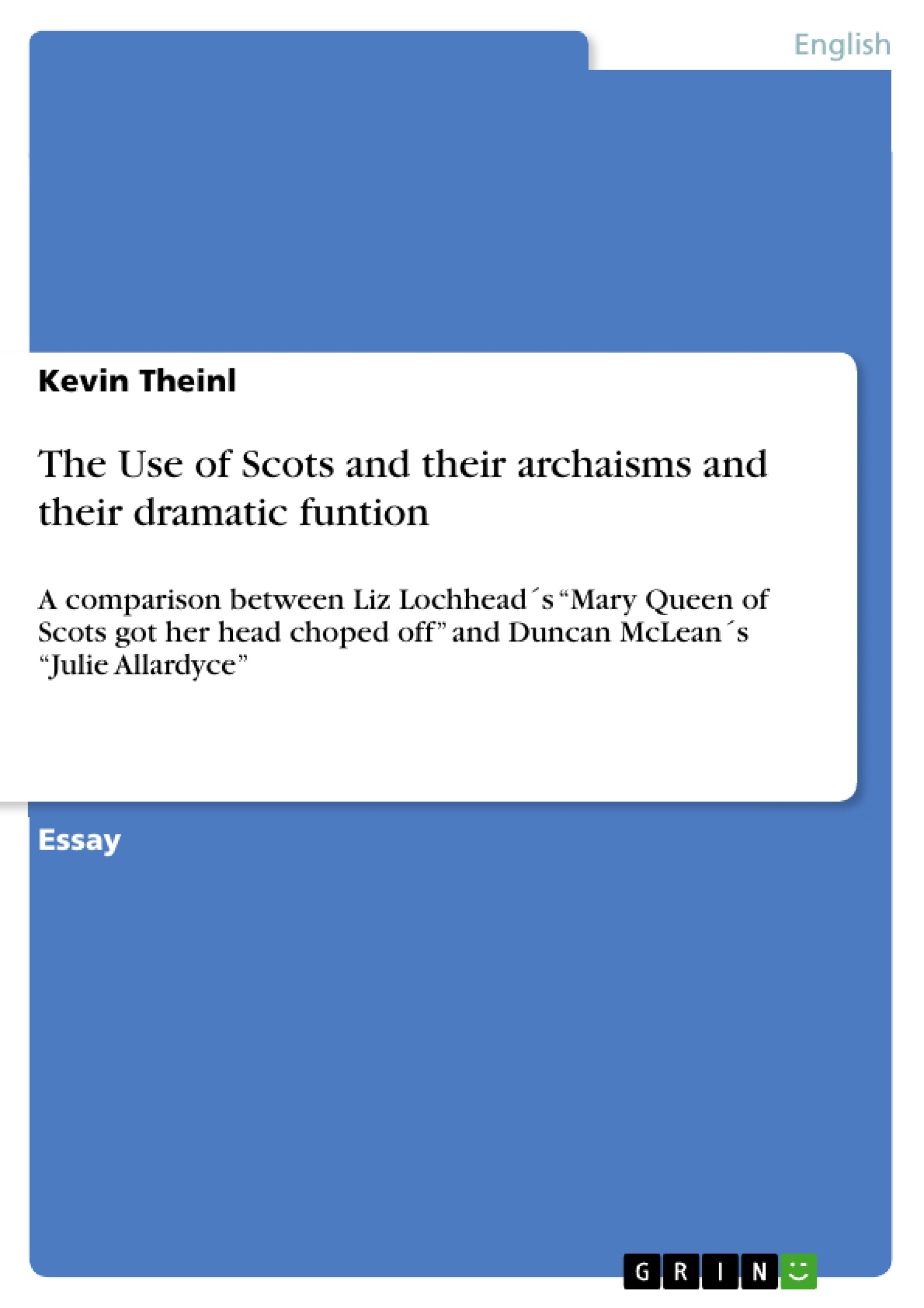The Scots language has to be enriched, so old vocabulary must resurrect. That includes the usage of internal borrowings. Archaic Scots lexis is used differently from play to play and I will examine the quantitative differences and literary effects, which arise from the lexis, on the basis of two modern Scottish theatre plays.
A drama is more qualified for an analysis of potential forms and functions of Scots than other sorts of texts. A more particular multifaceted usage of Scots is expected in a drama, because Scots is not a standardized form of speech and it is much more used in informally spoken language. The term “Scots” refers principally to the forms of speech in the Scottish lowlands, but in detail it can describe different things, for example a national language, or a collective of regional dialects or sociolects of the English language. These different dialects share a mutual distance to English, but are close to each other.
Scots lasts until today as a spoken language particularly in the lower social classes, even if it was tried to anglicize Scots and to banish that language. In the florescence of enlightenment the pronunciation became a status symbol and so a list of all scottisisms was published to force the Scottish people to rectify their language.
This essay deals with functions of Scots in a drama and the corpus of two modern Scottish theatre plays and the use of Scots and also Scots archaisms and their dramatic function within the plays. At first, I have chosen Liz Lochhead´s “Mary Queen of Scots got her head chopped off” and secondly Duncan McLean´s “Julie Allardyce” which I want to compare on the basis of quantitative differences in the usage of Scots types and the degree of obsolescence.
Inhaltsverzeichnis (Table of Contents)
- The Scots Language
- Functions of Scots in Drama
- Liz Lochhead's "Mary Queen of Scots got her head chopped off"
- The Use of Scots Archaisms
- Linguistic Varieties
- Quantitative Application of Scots
- Duncan McLean's "Julie Allardyce"
- Quantitative Application of Scots
- The Type and Density of Scots
Zielsetzung und Themenschwerpunkte (Objectives and Key Themes)
This essay analyzes the functions of Scots in modern Scottish theatre plays, particularly focusing on the quantitative differences and dramatic effects of Scots and its archaisms. The essay compares Liz Lochhead's "Mary Queen of Scots got her head chopped off" and Duncan McLean's "Julie Allardyce," examining the usage of Scots types and the degree of obsolescence in each play.
- The use of Scots in contemporary Scottish drama
- The dramatic functions of Scots and its archaisms
- Quantitative differences in the use of Scots and obsolete vocabulary in the two plays
- The relationship between language, character, and setting in Scottish theatre
- The challenges and potential of using Scots in modern drama for both historical and contemporary relevance.
Zusammenfassung der Kapitel (Chapter Summaries)
The essay begins by introducing the Scots language and its multifaceted nature, highlighting its historical context and challenges. It then examines the functions of Scots in drama, emphasizing its role in creating atmosphere, characterizing figures, and establishing setting. The essay then analyzes Liz Lochhead's "Mary Queen of Scots got her head chopped off," discussing the use of Scots archaisms, linguistic varieties, and the quantitative application of Scots in the play. The chapter concludes by examining how the play uses Scots to create specific dramatic effects and to portray historical and social contexts. The essay then proceeds to analyze Duncan McLean's "Julie Allardyce," focusing on its use of Scots and its quantitative application. The chapter discusses how McLean's use of Scots contributes to the characterization and authenticity of the dialogue.
Schlüsselwörter (Keywords)
The key themes and concepts in this essay include Scots language, Scottish drama, archaic language, quantitative analysis, dramatic function, characterization, setting, historical relevance, contemporary relevance, "Mary Queen of Scots got her head chopped off", "Julie Allardyce," Liz Lochhead, Duncan McLean, Scottish Literary Renaissance, Scottish identity, and gender stereotypes.
- Citation du texte
- Kevin Theinl (Auteur), 2010, The Use of Scots and their archaisms and their dramatic funtion, Munich, GRIN Verlag, https://www.grin.com/document/179366



